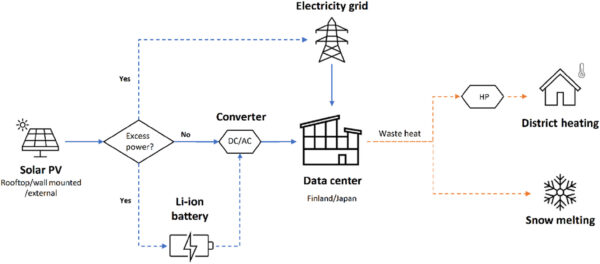An international research team has analyzed how solar PV could be utilized to power data centers (DCs) in cold climate regions, along with the utilization of the data center waste heat.
They simulated several scenarios of DCs located in Finland and northern Japan and considered energy prices for 2019, before the COVID-19 pandemic and before the energy crisis in Europe, and rates for 2023.
“Local renewable energy production and waste heat utilization are still rarely used in data centers, even though recent high electricity prices have considerably increased the economic value of self-generation and energy efficiency investments,” said the academics. “The benefits and cost-effectiveness of data center sustainability measures have also not yet been thoroughly researched in cold-climate regions, where the data center industry is currently growing rapidly.”
The DCs and the energy infrastructure were simulated on MATLAB, with two scenarios located in Helsinki and two scenarios located in the northern Japanese city of Sapporo. The electricity consumption data was based on recorded values for an operational DC in southern Finland, as well as modeled consumption profiles for a DC located in northern Japan.
“Both of these locations share a cold climate and many of the competitive advantages identified as key criteria for the DC industry, however, with distinct differences in solar PV effectiveness, electricity supply, and uses for waste heat,” emphasized the group. “Notably, the generation profile of solar PV systems.”
For each location, the academics simulated both a medium-sized DC, with a load of 2.5 MW, and a hyperscale DC, with a 25 MW load. In the Helsinki case, they considered using a 0.96 MW PV system on the roof of the smaller plant and 9.6 MW on the roof of the largest plant; in Japan, the load was 0.48 MW and 4.8 MW, respectively. In addition, in both locations, the smaller DCs had external PV production of 5 MW, and the hyperscale DCs had 50 MW. The smaller plants had a lithium-ion battery (LIB) of 10 MWh, while the larger ones had 100 MWh of storage.
“Each scenario assessed the effectiveness of both rooftop solar PV systems and external solar PV systems, with the option to either sell surplus solar PV electricity to the power grid or store it to meet demand in the following hours using LIBs,” said the group. “In the Helsinki scenarios, DC waste heat was used to produce district heating (DH) in the Helsinki region, whereas the Japan scenarios assessed the possibility of using waste heat for snow melting in the Sapporo region.”

Image: Aalto University, Renewable and Sustainable Energy Reviews, CC BY 4.0
The difference in waste heat utilization is due to the different conditions in the countries. While the existing DH networks in Finland could allow recovered waste heat to be effectively utilized for heating buildings, in northern Japan there is a high demand for more efficient ways of removing snow during the winter, with the city of Sapporo spending over €150 million ($163 million) annually.
“A rooftop solar PV system in both 2.5 MW and 25 MW data centers would have a life cycle cost (LCC) of around €1.30 million/MW in both Finland or Japan, whereas a larger PV system able to sell surplus electricity to the grid would cost between €0.96 million/MW and €1.21 million/MW over its lifetime in Finland, or between €1.03 million/MW and €1.12 million/MW in Japan,” the researchers explained.
According to their findings, the rooftop solar PV system would have a levelized cost of electricity (LCOE) of €89.1/MWh in Finland, compared to the cost of grid electricity at €59.7/MWh in 2019 and €171/MWh in 2022. The LCOE of the larger PV system varies between €74.8/MWh and €94.9/MWh depending on electricity prices.

Image: Aalto University, Renewable and Sustainable Energy Reviews, CC BY 4.0
“The higher overall electricity prices and better solar performance in Japan make both rooftop and larger solar PV systems profitable in most scenarios, as the LCOE of PV electricity is only between €62.9/MWh and €70.1/MWh compared to the LCOE of grid electricity at €126.8/MWh in 2019, and €223.2/MWh in 2023,” noted the group. “Similarly, the higher amount of solar irradiation available in northern Japan also makes battery storages more effective in Japan, with a LCOE of €176.9/MWh, making it a viable option at current electricity prices.”
“Selling surplus PV electricity to the grid and using waste heat for district heating is also shown to be effective in data centers located in Finland, whereas battery storage and snow melting are better suited to utilize surplus PV electricity and data center waste heat in northern Japan,” the academics conclued.
Their findings were presented in “Potential of solar photovoltaics and waste heat utilization in cold climate data centers. Case study: Finland and northern Japan,” published in Renewable and Sustainable Energy Reviews. The group comprised scientists from Finland’s Aalto University and Japan’s Hokkaido University.
This content is protected by copyright and may not be reused. If you want to cooperate with us and would like to reuse some of our content, please contact: editors@pv-magazine.com.



By submitting this form you agree to pv magazine using your data for the purposes of publishing your comment.
Your personal data will only be disclosed or otherwise transmitted to third parties for the purposes of spam filtering or if this is necessary for technical maintenance of the website. Any other transfer to third parties will not take place unless this is justified on the basis of applicable data protection regulations or if pv magazine is legally obliged to do so.
You may revoke this consent at any time with effect for the future, in which case your personal data will be deleted immediately. Otherwise, your data will be deleted if pv magazine has processed your request or the purpose of data storage is fulfilled.
Further information on data privacy can be found in our Data Protection Policy.